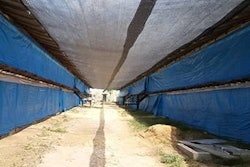
Endotoxins, also known as lipopolysaccharides (LPS), are part of the outer membrane of the cell wall of all gram-negative bacteria (e.g. E. coli, Salmonella, Shigella, Pseudomonas, among others) that are released from bacterial cell wall by shedding or through bacterial lysis.
While there are many natural sources of endotoxins -- for example, air, dust, food, water, and feces -- the major source is the gastrointestinal tract.
Consequences of endotoxin contamination
Poultry are continuously exposed to lipopolysaccharides throughout their lives. In healthy birds, the intestinal and other epitheliums such as skin or lungs, represent an effective barrier that prevents the passage of lipopolysaccharides into the bloodstream.
Once there, however, endotoxins can elicit strong immune responses, weakening birds’ immune systems and impairing performance. Severely pronounced immune response can lead to septic shock.
This activation of the immune system, along with increased oxidative stress, has been demonstrated in chicken cells in vitro. After incubation with different concentrations of lipopolysaccharides (20 and 40 ng/mL), a chicken macrophage cell line (HD11) showed increased oxidative stress, as demonstrated by enhanced levels of nitrite oxide (NO) production (Figure 1).
Recent research shows that exposure to lipopolysaccharides through dust in the environment impairs the immune response in chickens and can lower resistance against pathogenic insults. For these reasons, greater care regarding endotoxin exposure is crucial for proper animal health and performance.
Aggravation of endotoxin exposure
In recent years, new concerns have emerged about nutritional, environmental and social factors that may disrupt the barrier function and/or increase exposure to lipopolysaccharides. Such exposure may result in clinical or sub-clinical signs that ultimately affect poultry production. Septic shock is very often related to infection by pathogenic gram-negative bacteria that produce lipopolysaccharides.
However, the presence of lipopolysaccharides in blood can also be due to metabolic or gut barrier problems (Table 1) along with issues related to the intestinal microflora. Given that many of the factors vary from bird to bird, a combination of factors as a whole will result in disparate impacts within a flock.
Dietary changes play a clear role. For example, moving birds from a corn-based diet to a rye-wheat-barley diet results in increased lipopolysaccharide levels in blood serum along with an increase in inflammatory markers.
Other factors can significantly contribute to endotoxin-associated problems. For instance, in summer, high temperatures inside poultry units can induce heat stress. In other livestock species, it is well established that a 1-20C increase in inner body temperature causes the intestinal tight junction proteins to to be affected, thereby increasing intestinal permeability and allowing more lipopolysaccharides to enter the blood stream. Whether the same mechanism applies to poultry is under investigation.
Mycotoxins found in feed also aggravate exposure to endotoxins. According to the latest Biomin Mycotoxin Survey results, the presence of deoxynivalenol, zearalenone and fumonisins in finished feed have all increased in recent years (Figure 2). Mycotoxins such as deoxynivalenol are very well known to disrupt the intestinal barrier.
Additionally, sub therapeutic use of antibiotics in some countries not only raises concerns about antibiotic resistance but also about the change in gut microflora and the plausible release of lipopolysaccharides in the gut lumen.
Environment and endotoxin exposure
While the main route for lipopolysaccharide exposure in poultry is the gastrointestinal tract, the concentration of endotoxins in the air and dust should not be overlooked - endotoxins are a major component of biological dust.
Air endotoxin levels are an important issue not only for the animals, but also for workers in poultry houses.
The highest concentrations of airborne endotoxins among livestock production facilities have been recorded on poultry farms at 310 to 1090 ng/m3 air. This reinforces the importance of good management regarding hygiene and dust levels on farms, and specific measures to protect workers such as wearing a fine dust mask.
Recent research shows the impaired performance and weaker immune function resulting from endotoxin contamination. The multitude of factors relating to lipopolysaccharide exposure helps explain the disparate impact on birds. Given the health issues for birds and workers, greater attention to endotoxins is needed.

















